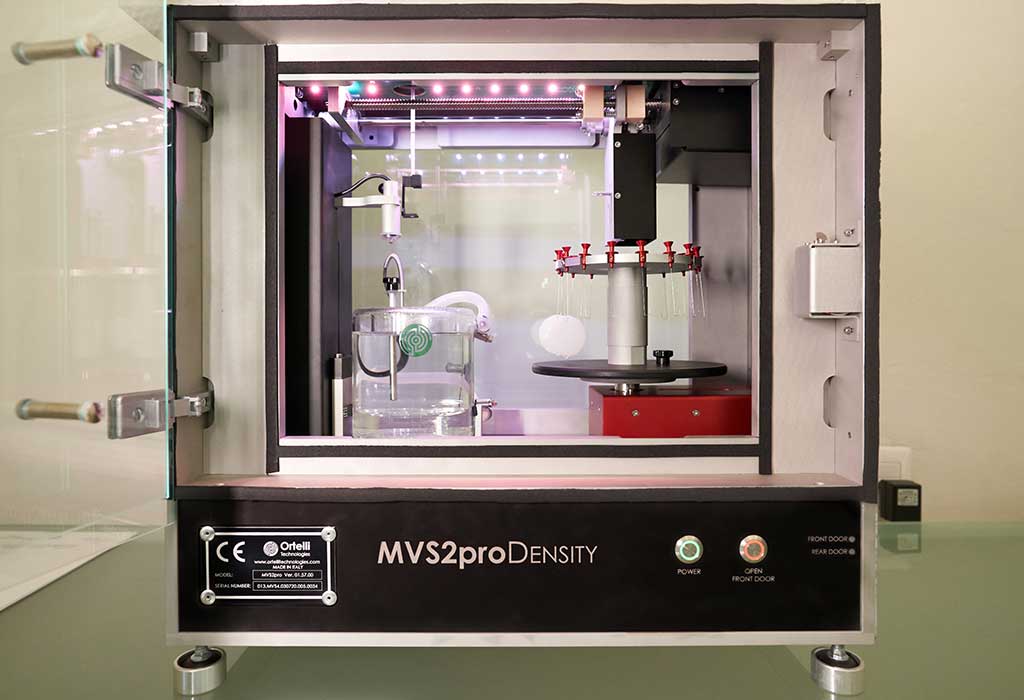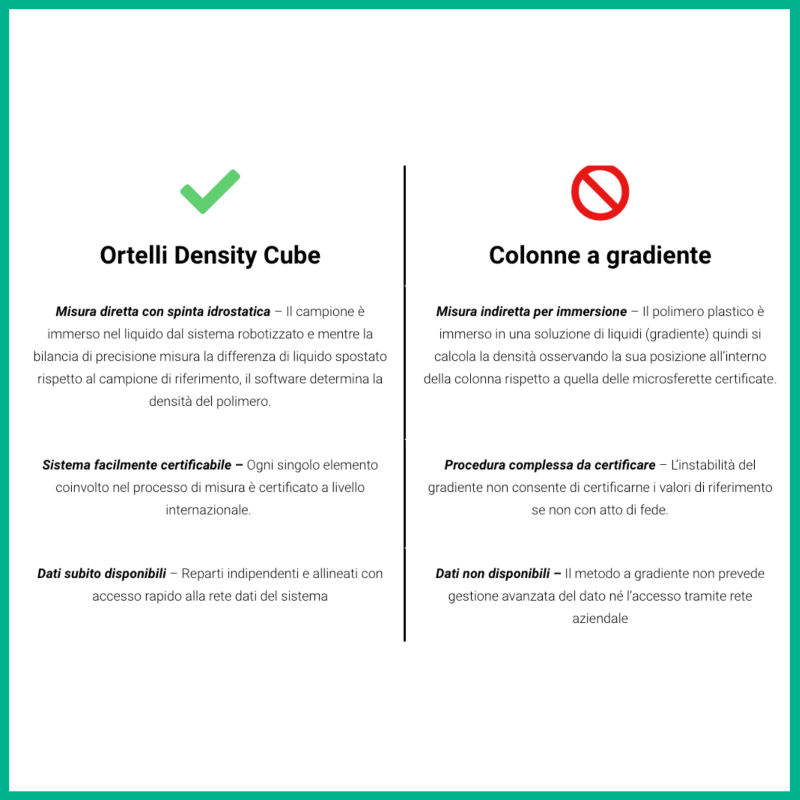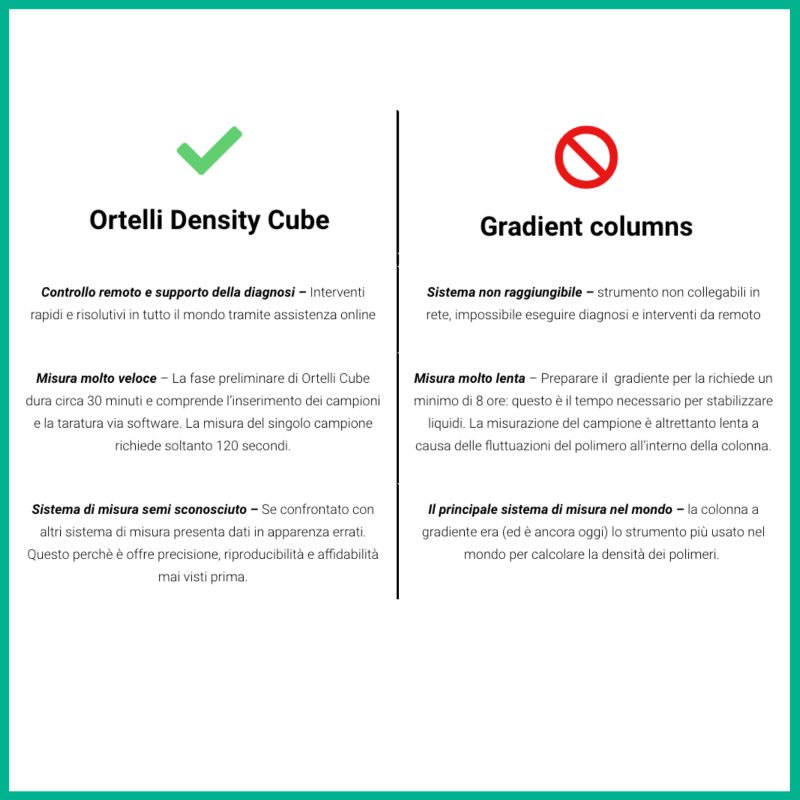
Ortelli Density Cube: establishes in a
VERIFIABLE
SURE
FAST
the absolute standard density – MVS – of thermoplastic polymers (HDPE).
The Ortelli Density Cube determines the density in a fully automated cycle: this method replaces the old gradient column measurement system.
How does the Ortelli Density Cube work?
A robotic analytical process based on hydrostatic pressure.
Ortelli Density Cube (MVS2pro) has an auto-sampler capable of analyzing 16 samples and / or mass’ standards, density or volume in an automatic sequence.
The Ortelli Density Cube measures the sample by dipping it into a liquid with a known and certified density while the temperature is kept constant, regardless of the external heat.
The complete automation excludes external environment’s interferences from the process.
Standard density in 6 steps
The instrument is completely robotic and after preparing the samples:
ONE. The probe withdraw the samples by bringing them closer to the measuring system
TWO. The sample is measured in air by the analytical balance.
THREE.The sample is dippened in the liquid
FOUR. The scales takes the measurement
FIVE. The software processes the obtained data
SIX. The results are shown on the screen in a very short time
The specific software: ally of reliability and precision.
The Ortelli Density Cube system (MVS2pro) can be controlled both from a directly connected PC and remotely from a clear interface; the configuration of all the components is simple, practical and intuitive.
The row data remain in the records.
In a short time it’ll be possible to trace the historical data and all the measurements made to obtain those data; it will be possible to calculate again the data stored with other kinds of applications such as Excel or Access and then transfer them directly to the LIMS.
The system can be integrated within the company LAN to send analytical data to the automatically identified areas of competence.
Comparison
Ortelli Density Cube
Gradient columns
Direct measurement with hydrostatic thrust method – The sample is dipped into a liquid by a robotic system and while the precision scales measures the difference in displaced liquid compared to the reference sample, the software determines the actual density of the polymer.
Resulting measurement by immersion – The plastic polymer is immersed in a liquid solution (gradient) and the density is calculated by noting its position inside the column compared to that of the certified microspheres.
Easily certifiable system – Every single element involved in the measurement process is internationally certified.
Complex procedure to be certified – The instability of the gradient does not allow to certify the reference values except with an act of faith.
Data immediately available – Independent, aligned departments with quick access to the system’s data network.
Data not available – The gradient method does not provide for advanced data management or access via the company network.
Remote control and diagnosis support – Quick and decisive interventions all over the world through online assistance.
System not reachable – instrument cannot be connected to the network, it is impossible to carry out remote diagnostics and interventions.
Very fast measurement – The preliminary phase of Ortelli Cube lasts about 30 minutes and includes the insertion of samples and calibration via software. The measurement of the single sample takes only 120 seconds.
Very slow measurement – Preparing the gradient for the measurement takes a minimum of 8 hours: this is the time that it takes to fix the liquids. The measurement of the sample is just as slow due to the fluctuations of the polymer inside the column.
Semi-unknown measurement system – If compared with other measurement systems, it presents incorrect data. This is because it offers never before seen accuracy, reliability and authenticity.
The main measuring system in the world – the gradient column was (and still is today) the most used tool in the world to calculate the density of polymers.
Result not influenced by external conditions– The system is automatic and works in a protected environment capable of recreating the same measurement conditions every single time. The influence given by the operator’s skills or the external temperature is reset.
Result influenced by the technical skills of the operator – In most gradient columns the operator observes the position of the polymer to establish its density. The angle of the gaze and subjective skills lead to values that are different from objective reality.
Tax concessions – purchasable through the tax concessions provided for by the international transition plan 4.0. The rental option is also available.
Not compliant with tax breaks – Gradient columns do not fit into the 4.0 transition plane.
Passage to a new measurement method makes it difficult by emotions – News creates confusion and challenging the current state of things (admitting inaccuracies in the results that has always been obtained) creates an emotional discomfort.
Maintaining old habits does not require any steps
– Questioning the new (and more generally what you don’t deeply know) is a mechanism for defending our habits.



